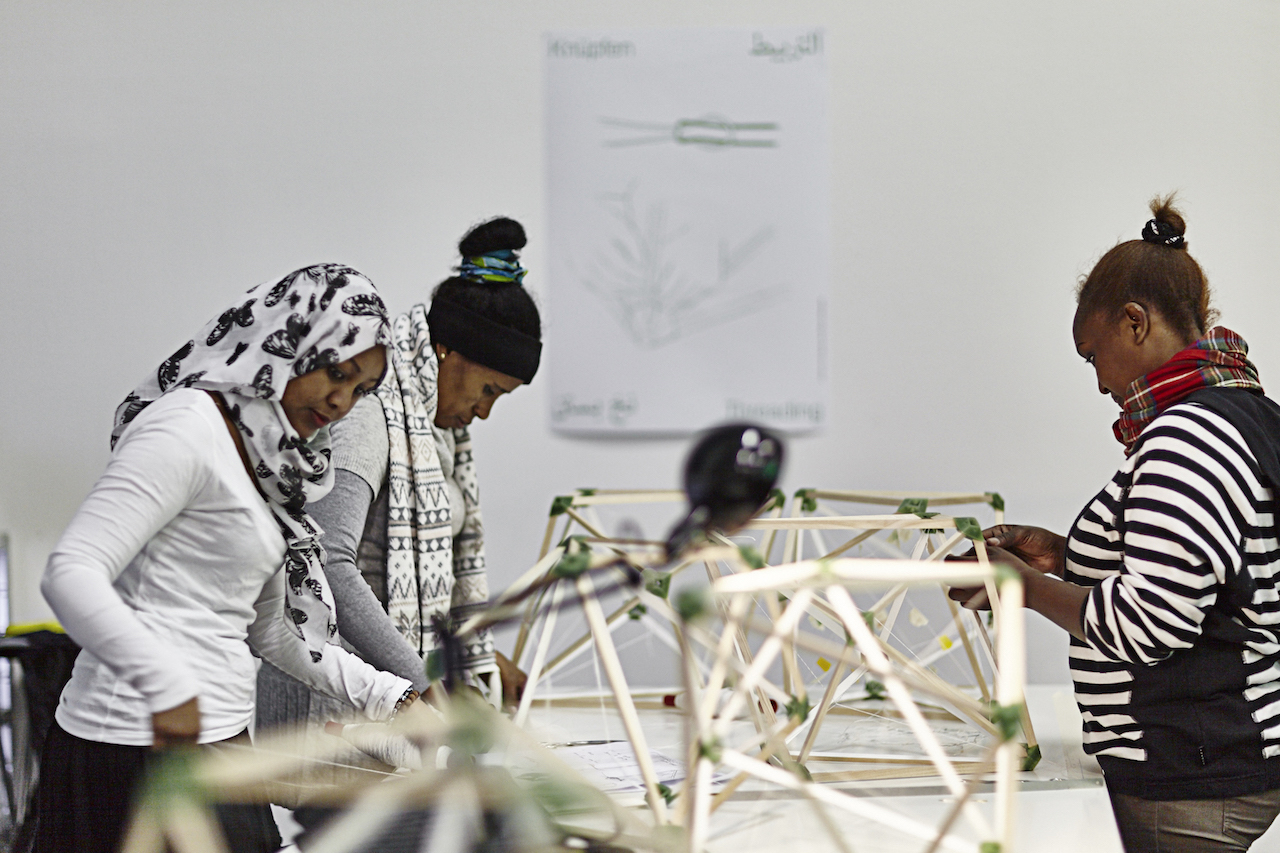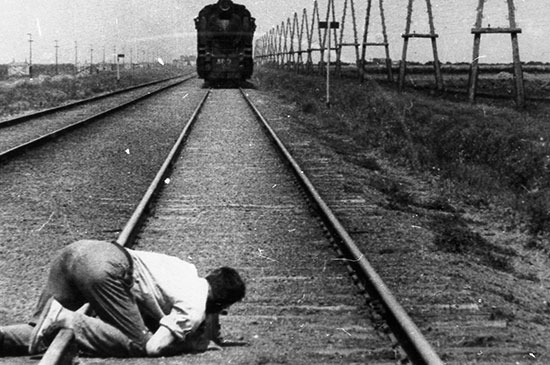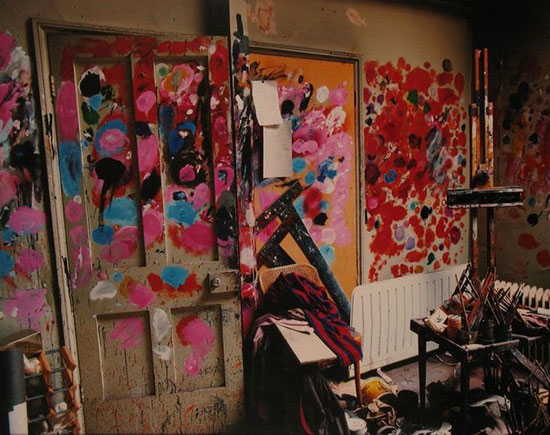Περί αλλοτινών χώρων (Des espaces autres) (1967), Ετεροτοπίες Μισέλ Φουκώ
Όπως όλοι γνωρίζουμε, η μεγάλη εμμονή που κυρίευσε τον 19ο αιώνα ήταν η ιστορία: ζητήματα ανάπτυξης και στασιμότητας, ζητήματα κρίσεων και κυκλικότητας, ζητήματα συσσώρευσης του παρελθόντος, μεγάλος αριθμός νεκρών, η απειλητική πτώση της θερμοκρασίας του πλανήτη. Ο 19ος αιώνας άντλησε τις βασικές μυθολογικές πηγές του από τον δεύτερο νόμο της θερμοδυναμικής. Η σημερινή εποχή θα μπορούσε να χαρακτηριστεί περισσότερο ως η εποχή του χώρου. Διανύουμε την εποχή του ταυτόχρονου, την εποχή της αντιπαραβολής, του κοντινού και του μακρινού, του πλάι πλάι, της διάχυσης. Βρισκόμαστε, κατά την άποψή μου, σε ένα σημείο όπου ο κόσμος δίνει την εντύπωση λιγότερο μιας μεγαλειώδους ζωής που εξελίσσεται με την πάροδο του χρόνου και περισσότερο ενός δικτύου το οποίο ενώνει σημεία υφαίνοντας τον ιστό του. Θα μπορούσαμε ίσως να ισχυριστούμε ότι ορισμένες από τις ιδεολογικές συγκρούσεις οι οποίες ενέπνευσαν την πολεμική της εποχής μας εκτυλίσσονται ανάμεσα στους πιστούς απόγονους του χρόνου και στους επίμονους κατοίκους του χώρου. Ο στρουκτουραλισμός, ή τουλάχιστον η γενικότερη έννοια που κατηγοριοποιείται υπό αυτόν τον όρο, είναι η προσπάθεια δημιουργίας, με στοιχεία διασκορπισμένα στο χρονικό γίγνεσθαι, ενός συνόλου σχέσεων οι οποίες δίνουν την εντύπωση της αντιπαραβολής, της αντιπαράθεσης, της μεταξύ τους ανάμειξης, ή μάλλον την εντύπωση ενός διαμορφωμένου συστήματος. Στην πραγματικότητα, ο στρουκτουραλισμός δεν συνεπάγεται την άρνηση του χρόνου. Αποτελεί έναν συγκεκριμένο τρόπο διαχείρισης αυτών που αποκαλούμε χρόνος και ιστορία.
Πρέπει να τονίσουμε πάντως ότι ο χώρος που μας απασχολεί σήμερα μέσα από τη θεωρία και τα συστήματά μας, δεν αποτελεί καινοτομία. Ο χώρος από μόνος του, σύμφωνα με τη δυτική εμπειρία, έχει τη δική του ιστορία, και δεν είναι δυνατόν να παραβλέψουμε αυτή την αναπόφευκτη διασύνδεση του χρόνου με τον χώρο. Θα μπορούσαμε να ισχυριστούμε, για να περιγράψουμε πολύ γενικά αυτήν την ιστορία του χώρου, ότι κατά τον Μεσαίωνα υπήρχε ένα ιεραρχικό σύνολο τόπων: τόποι ιεροί και τόποι κοσμικοί, τόποι προστατευμένοι και τόποι ανοιχτοί και απροστάτευτοι, αστικοί και αγροτικοί τόποι (όπου ζούσαν πραγματικά οι άνθρωποι). Σύμφωνα με την κοσμολογική θεωρία, υπήρχαν τόποι υπερουράνιοι σε αντιπαραβολή προς τους ουράνιους και τόποι ουράνιοι με τη σειρά τους σε αντιπαραβολή προς τους επίγειους. Υπήρχαν τόποι όπου τα πράγματα είχαν τοποθετηθεί επειδή είχαν μετακινηθεί με τη βία και, αντίθετα, τόποι όπου τα πράγματα έβρισκαν τη φυσική θέση και ακινησία τους. Αυτή ακριβώς η ιεραρχία, αυτή η αντίθεση, αυτή η διασύνδεση των τόπων αποτέλεσε αυτό που μπορούμε να αποκαλέσουμε σε γενικές γραμμές μεσαιωνικό χώρο: ο χώρος της φυσικής θέσης (localisation).
1
Αυτός ο χώρος διευρύνθηκε από τον Γαλιλαίο. Διότι το πραγματικό σκάνδαλο στο έργο του Γαλιλαίου, δεν ήταν τόσο ότι ανακάλυψε ότι η Γη γυρίζει γύρω από τον Ήλιο, αλλά ότι δημιούργησε έναν χώρο απέραντο και απολύτως ανοιχτό, με αποτέλεσμα να καταλυθεί τελείως η μεσαιωνική αντίληψη του χώρου, αφού ο τόπος ενός πράγματος δεν ήταν πια παρά ένα σημείο στην κίνησή του, όπως ακριβώς η ακινησία ενός πράγματος δεν ήταν παρά η απεριόριστη επιβράδυνση της κίνησής του. Με άλλα λόγια, από την εποχή του Γαλιλαίου και ξεκινώντας από τον 19ο αιώνα, την φυσική θέση υποκαθιστά η ευρύτητα (etendue).
Στις μέρες μας, η θέση στο χώρο (emplacement) αντικαθιστά την ευρύτητα, η οποία με τη σειρά της υποκατέστησε τη φυσική θέση. Η θέση στο χώρο προσδιορίζεται από τις σχέσεις γειτονίας μεταξύ σημείων ή στοιχείων. Τυπικά, μπορούμε να τις περιγράψουμε ως σειρές, άξονες, κιγκλίδες.
Από την άλλη πλευρά, γνωρίζουμε τη σημασία των προβλημάτων της θέσης στον χώρο στη σύγχρονη τεχνική: η αποθήκευση πληροφοριών ή των ενδιάμεσων αποτελεσμάτων ενός υπολογισμού στη μνήμη μιας μηχανής, η κυκλοφορία απόρρητων στοιχείων, με τυχαία έξοδο (όπως για παράδειγμα τα αυτοκίνητα ή ακόμη και οι ήχοι μιας τηλεφωνικής γραμμής), η σηματοδότηση στοιχείων που φέρουν σήμα ή κωδικοποίηση, εντός ενός συνόλου το οποίο είναι είτε τυχαία κατανεμημένο, είτε ταξινομημένο σύμφωνα με μια μεμονωμένη ή πολλαπλές ταξινομήσεις, κλπ.
Κατά έναν ακόμη πιο συγκεκριμένο τρόπο, το πρόβλημα της θέσης τίθεται για τους ανθρώπους με όρους δημογραφικούς. Και αυτό το τελευταίο πρόβλημα της ανθρώπινης θέσης, δεν είναι απλά το ερώτημα εάν θα υπάρξει αρκετός χώρος για την ανθρωπότητα στον πλανήτη, πρόβλημα ούτως ή άλλως αρκετά σημαντικό, αλλά παράλληλα το πρόβλημα των σχέσεων γειτνίασης, του είδους της αποθήκευσης, κυκλοφορίας, σηματοδότησης, κατηγοριοποίησης των ανθρώπινων στοιχείων που πρέπει να υιοθετηθούν σε δεδομένες καταστάσεις προκειμένου να επιτευχθεί ο ένας ή ο άλλος στόχος. Βρισκόμαστε σε μια εποχή όπου ο χώρος λαμβάνει τη μορφή σχέσεων θέσης.
Σε κάθε περίπτωση, πιστεύω ότι οι ανησυχίες μας σήμερα αφορούν πρωταρχικά το χώρο, προφανώς πολύ περισσότερο απ’ ότι τον χρόνο. Ο χρόνος εμφανίζεται πιθανόν ως μία από τις διάφορες επιμεριστικές λειτουργίες των στοιχείων τα οποία κατανέμονται στον χώρο.
Παρά τις όποιες τεχνικές που τον περιβάλλουν, παρά τα δίκτυα γνώσης που μας επιτρέπουν να τον προσδιορίσουμε ή να τον τυποποιήσουμε, ο σύγχρονος χώρος δεν είναι ίσως ακόμη πλήρως απαλλαγμένος από τον ιερό του χαρακτήρα, σε αντίθεση με τον χρόνο, ο οποίος το έχει επιτύχει από τον 19ο αιώνα. Βέβαια, έχει πραγματοποιηθεί μια ορισμένη θεωρητική απομάκρυνση του χώρου από τον ιερό του χαρακτήρα (για την οποία έδωσε το έναυσμα το έργο του Γαλιλαίου), όμως ίσως να μην έχουμε αγγίξει ακόμη την πρακτική αποαγιοποίηση του χώρου. Και ίσως ακόμη η ίδια η ζωή μας να κυβερνάται από συγκεκριμένες αντιθέσεις τις 2
οποίες δεν μπορούμε να αγγίξουμε, τις οποίες οι θεσμοί και οι πρακτικές μας δεν τολμούν ακόμη να θίξουν, αντιθέσεις τις οποίες δεχόμαστε ως δεδομένες: για παράδειγμα, μεταξύ του ιδιωτικού και του δημόσιου χώρου, του οικογενειακού και του κοινωνικού χώρου, του πολιτισμικού χώρου και του χώρου κοινής ωφέλειας, μεταξύ του χώρου αναψυχής και του χώρου εργασίας. Όλες αυτές οι αντιθέσεις εξακολουθούν να χαρακτηρίζονται από μια δεδομένη ιερότητα.
Το τεράστιο έργο του Bachelard, οι περιγραφές των φαινομενολόγων, μας έχουν δείξει ότι δεν ζούμε σε έναν ομοιογενή και άδειο χώρο, αλλά αντιθέτως, σε έναν χώρο εμποτισμένο με χαρακτηριστικά, έναν χώρο ίσως και στοιχειωμένο από τη φαντασίωση. Ο χώρος της πρωταρχικής μας αντίληψης, ο χώρος των ονείρων μας, ο χώρος των παθών μας, περικλείουν εγγενή χαρακτηριστικά. Πρόκειται για έναν χώρο ανάλαφρο, αιθέριο, διαφανή, ή ακόμη για έναν χώρο σκοτεινό, τραχύ, παραφορτωμένο: πρόκειται για έναν άνω χώρο, τον χώρο της κορυφής, ή αντίθετα έναν κάτω χώρο, τον χώρο της λάσπης. Ένας χώρος που μπορεί να ρέει όπως το γάργαρο νερό, ή ένας χώρος σταθερός, μαρμαρωμένος όπως η πέτρα ή το κρύσταλλο.
Ωστόσο, αυτές οι αναλύσεις, ενώ είναι θεμελιώδεις για τον σύγχρονο προβληματισμό, αφορούν κυρίως τον εσωτερικό χώρο. Εγώ θα ήθελα να μιλήσω τώρα για τον εξωτερικό χώρο. Ο χώρος μέσα στον οποίο ζούμε, ο οποίος μας παρασύρει έξω από τον εαυτό μας, είναι ο χώρος όπου πραγματοποιείται όντως η διάβρωση της ζωής, του χρόνου και της ιστορίας μας, ο χώρος που μας κατατρώει και μας σημαδεύει είναι και ο ίδιος ένας ετερογενής χώρος. Με άλλα λόγια, δεν ζούμε σε ένα κενό, στο οποίο μπορεί κανείς να τοποθετήσει άτομα και πράγματα. Δεν ζούμε μέσα σε ένα κενό, που μπορεί να χρωματιστεί με διάφορες αποχρώσεις, αλλά σε ένα σύνολο από σχέσεις που προσδιορίζουν θέσεις απαράβατες και σε καμία περίπτωση υπερκείμενες μεταξύ τους.
Βέβαια, θα μπορούσε κανείς να επιχειρήσει να περιγράψει αυτές τις διάφορες θέσεις, αναζητώντας το σύνολο των σχέσεων με βάση τις οποίες μπορούμε να προσδιορίσουμε την εν λόγω θέση. Για παράδειγμα, η περιγραφή του συνόλου των σχέσεων που προσδιορίζουν τις θέσεις διέλευσης, τις οδούς, τα τρένα (το τρένο είναι μια εξαιρετική δέσμη σχέσεων, καθώς αποτελεί κάτι με το οποίο κάποιος διέρχεται, μέσο με το οποίο κάποιος μπορεί να μεταφερθεί από ένα σημείο σε κάποιο άλλο και ταυτόχρονα ένα αντικείμενο που περνάει). Θα μπορούσαμε να περιγράψουμε μέσω της δέσμης των σχέσεων που μας επιτρέπουν να τις προσδιορίσουμε, τις θέσεις αυτές της προσωρινής στάσης, όπως τα καφέ, οι κινηματογράφοι, οι παραλίες. Θα μπορούσαμε επίσης να προσδιορίσουμε, μέσω ενός τέτοιου δικτύου σχέσεων, τις κλειστές ή σχεδόν κλειστές θέσεις ανάπαυσης, όπως είναι το σπίτι, το δωμάτιο, το κρεβάτι, κλπ. Αυτό όμως που με ενδιαφέρει μεταξύ όλων των άλλων θέσεων είναι ορισμένες θέσεις οι οποίες διαθέτουν την παράδοξη ιδιότητα να συνδέονται με όλες τις άλλες θέσεις, αλλά με τέτοιον τρόπο ώστε να αναιρούν, να εξουδετερώνουν ή να αντιστρέφουν το 3
σύνολο των σχέσεων τις οποίες τυγχάνει να καθορίζουν, να καθρεφτίζουν ή να αντανακλούν. Κατά κάποιον τρόπο, οι χώροι αυτοί, που συνδέονται με όλους τους άλλους, οι οποίοι ωστόσο αναιρούν όλες τις άλλες θέσεις, διαιρούνται σε δύο μεγάλες κατηγορίες. ΕΤΕΡΟΤΟΠΙΕΣ Κατ’ αρχήν υπάρχουν ουτοπίες. Οι ουτοπίες, αποτελούν θέσεις χωρίς πραγματικό τόπο. Είναι οι θέσεις που διατηρούν με τον πραγματικό χώρο της κοινωνίας μία γενική σχέση άμεσης ή αντίστροφης αναλογίας. Αποτελούν έκφραση της ίδιας της κοινωνίας σε τελειοποιημένη μορφή, ή της ανάποδης πλευράς της κοινωνίας, αλλά σε κάθε περίπτωση, οι ουτοπίες αυτές αποτελούν ουσιαστικά μη πραγματικούς χώρους.
Υπάρχουν εξίσου, και αυτό ίσως συμβαίνει σε κάθε κουλτούρα, σε κάθε πολιτισμό, πραγματικοί τόποι, τόποι λειτουργικοί, τόποι που έχουν σχεδιαστεί εντός του θεσμού ακόμη και της ίδιας της κοινωνίας, και οι οποίοι αποτελούν κάποιο είδος αντι-θέσεων, είδος ουτοπιών που έχουν γίνει πράξη, εντός των οποίων οι πραγματικές θέσεις, όλες οι υπόλοιπες πραγματικές θέσεις που μπορεί κανείς να βρει στο εσωτερικό μιας κουλτούρας αντιπροσωπεύονται ταυτόχρονα, αμφισβητούνται και ανατρέπονται. Υπάρχουν είδη τόπων που βρίσκονται έξω από όλους τους τόπους, ακόμη και αν είναι εύκολο να προσδιοριστεί η τοποθεσία τους. Επειδή οι τόποι αυτοί είναι τελείως διαφορετικοί από όλες τις άλλες θέσεις τις οποίες αντανακλούν και στις οποίες αναφέρονται, θα τους αποκαλώ, σε αντίθεση με τις ουτοπίες, ετεροτοπίες. Πιστεύω ότι μεταξύ των ουτοπιών και των υπολοίπων εντελώς διαφορετικών θέσεων, αυτών των ετεροτοπιών, υπάρχει προφανώς ένα είδος μεικτής, ενδιάμεσης εμπειρίας, ένα είδος καθρέφτη. Άλλωστε ο καθρέφτης αποτελεί μία ουτοπία, αφού είναι ένας τόπος χωρίς τόπο. Στον καθρέφτη βλέπω τον εαυτό μου εκεί όπου δεν βρίσκομαι, σε έναν χώρο μη πραγματικό που ανοίγεται με εικονικό τρόπο κάτω από την επιφάνεια. Βρίσκομαι εκεί, σε μέρος όπου δεν βρίσκομαι, ένα είδος σκιάς που μου δίνει τη δυνατότητα να βλέπω τον εαυτό μου, που μου επιτρέπει να βλέπω τον εαυτό μου εκεί απ’ όπου απουσιάζω – αυτή είναι η ουτοπία του καθρέφτη. Αλλά είναι εξίσου μια ετεροτοπία, στο βαθμό όπου ο καθρέφτης υπάρχει στην πραγματικότητα και παρουσιάζει μια αντανάκλαση της θέσης στην οποία βρίσκομαι. Χάρη στον καθρέφτη ανακαλύπτω την απουσία μου από το μέρος όπου βρίσκομαι καθώς βλέπω εκεί τον εαυτό μου. Ξεκινώντας από αυτό το βλέμμα, το οποίο με κάποιον τρόπο στρέφεται προς εμένα, από το βάθος αυτού του εικονικού χώρου στην άλλη πλευρά του γυαλιού, επιστρέφω στον εαυτό μου και ξαναρχίζω να στρέφω το βλέμμα μου σε μένα και να τοποθετώ τον εαυτό μου στο σημείο όπου βρίσκομαι. Ο καθρέφτης λειτουργεί σαν μια ετεροτοπία υπό την έννοια ότι καθιστά το μέρος όπου βρίσκομαι τη στιγμή που κοιτάζομαι στο τζάμι ταυτόχρονα απολύτως πραγματικο, συνδεδεμένο με όλο το χώρο που το 4
περιβάλλει, και απολύτως μη πραγματικό, καθώς προκειμένου να γίνει αντιληπτό (το μέρος) είναι υποχρεωμένο να περάσει μέσα από αυτό το εικονικό σημείο που βρίσκεται εκεί.
Όσον αφορά τις καθεαυτού ετεροτοπίες, πώς μπορούν να περιγραφούν; Ποιο είναι το νόημά τους; Θα μπορούσε κανείς να υποθέσει ότι αποτελούν ένα είδος συστηματικής περιγραφής, δεν χρησιμοποιώ τον όρο επιστήμη επειδή πρόκειται για μία λέξη με υπερβολική συχνότητα χρήσης στις μέρες μας, μια περιγραφή η οποία, σε μια δεδομένη κοινωνία, θα μπορούσε να έχει ως αντικείμενό της τη μελέτη, την ανάλυση, την περιγραφή, την «ανάγνωση», όπως προτιμούν ορισμένοι να την αποκαλούν στην εποχή μας, αυτών των διαφορετικών χώρων, των άλλων τόπων. Ένας χώρος μυθικής και ταυτόχρονα πραγματικής διεκδίκησης του χώρου στον οποίο ζούμε. Η περιγραφή αυτή θα μπορούσε να ονομαστεί ετεροτοπολογία. Η πρώτη αρχή είναι ότι πιθανόν δεν υπάρχει καμία κουλτούρα στον κόσμο η οποία να μην δημιουργεί ετεροτοπίες. Αυτό αποτελεί σταθερά κάθε ανθρώπινης ομάδας. Οι ετεροτοπίες όμως λαμβάνουν φυσικά μορφές εντελώς διαφοροποιημένες, και ίσως κανείς δεν μπορεί να βρει μία μοναδική μορφή ετεροτοπίας η οποία θα είναι απολύτως παγκόσμια. Ωστόσο, μπορούμε να τις κατηγοριοποιήσουμε σε δύο μεγάλες ομάδες. Στις λεγόμενες “πρωτόγονες” κοινωνίες, υπάρχει μία συγκεκριμένη μορφή ετεροτοπιών τις οποίες εγώ ονομάζω ετεροτοπίες κρίσης, δηλαδή υπάρχουν τόποι προνομιούχοι, ή ιεροί, ή απαγορευμένοι, φυλαγμένοι για άτομα που βρίσκονται, αναφορικά με την κοινωνία και το ανθρώπινο περιβάλλον στο οποίο ζουν, σε κατάσταση κρίσης: έφηβοι, γυναίκες τη διάρκεια της έμμηνου ρύσης, σε κατάσταση εγκυμοσύνης, ηλικιωμένοι, κλπ.
Στην κοινωνία μας, αυτές οι ετεροτοπίες κρίσης εξαφανίζονται διαρκώς, παρόλο που κάποιες εξακολουθούν να επιβιώνουν. Για παράδειγμα, το γυμνάσιο, υπό τη μορφή που είχε τον 19ο αιώνα, ή η στρατιωτική θητεία για τους άνδρες διαδραμάτισαν αναμφισβήτητα έναν τέτοιο ρόλο, οι πρώτες εκδηλώσεις της ανδρικής σεξουαλικότητας έπρεπε στην πραγματικότητα να πραγματοποιηθούν οπουδήποτε «αλλού», εκτός από την οικογένεια. Για τα κορίτσια, μέχρι τα μέσα του 20ου αιώνα, υπήρχε μία παράδοση που λεγόταν «ταξίδι του μέλιτος», η οποία αποτελούσε προγονικό ζήτημα. Η εκπαρθένευση της νεαρής κοπέλας δεν μπορούσε να συμβεί «πουθενά» και, τη στιγμή της πραγματοποίησής της το τρένο, το ταξίδι του μέλιτος, αποτελούσε πράγματι τον τόπο αυτού του πουθενά, αυτήν την ετεροτοπία χωρίς γεωγραφικά σημεία αναφοράς.
Αυτές οι ετεροτοπίες κρίσης όμως εξαφανίζονται στις μέρες μας και αντικαθίστανται, κατά τη γνώμη μου, από ετεροτοπίες απόκλισης, όπως θα μπορούσαμε να τις ονομάσουμε: αυτές στις οποίες τοποθετούνται άτομα με συμπεριφορά αποκλίνουσα σε σχέση με το μέσο όρο ή κανόνα. Τέτοιες περιπτώσεις αποτελούν τα αναρρωτήρια, οι ψυχιατρικές κλινικές και φυσικά οι φυλακές, και ίσως θα έπρεπε να προσθέσουμε χωρίς ενδοιασμό και τους οίκους ευγηρίας, οι οποίοι βρίσκονται κατά κάποιον τρόπο στη διαχωριστική γραμμή μεταξύ της ετεροτοπίας 5
κρίσης και της ετεροτοπίας απόκλισης, αφού τελικά τα γηρατειά αποτελούν μια κρίση, αλλά και μια απόκλιση σε μια κοινωνία όπου οι δραστηριότητες αναψυχής είναι ο κανόνας και η αδράνεια αποτελεί μια μορφή απόκλισης. Η δεύτερη αρχή αυτής της περιγραφής των ετεροτοπιών, είναι ότι μια κοινωνία, κατά την ιστορική εξέλιξή της, μπορεί να κάνει μια ήδη υπάρχουσα ετεροτοπία, η οποία δεν εξαφανίστηκε ποτέ, να λειτουργήσει κατά τρόπο τελείως διαφορετικό. Πράγματι, κάθε ετεροτοπία διαθέτει μια σαφή και καθορισμένη λειτουργία σε μια κοινωνία, και η ίδια ετεροτοπία μπορεί, ανάλογα με την συγχρονικότητα της κουλτούρας στην οποία βρίσκεται να έχει μια διαφορετική λειτουργία.
Παίρνω για παράδειγμα την παράξενη ετεροτοπία του νεκροταφείου. Το νεκροταφείο είναι σίγουρα ένας τόπος διαφορετικός από τους συνήθεις πολιτισμικούς χώρους. Πρόκειται για έναν χώρο ο οποίος συνδέεται κατά βάση με όλους τους χώρους μιας πόλης ή μιας κοινωνίας ή ενός χωριού, καθώς κάθε άτομο, κάθε οικογένεια έχει συγγενείς στο νεκροταφείο. Στη δυτική κουλτούρα, το νεκροταφείο πρακτικά υπήρχε πάντα. Έχει υποστεί όμως σημαντικές μεταβολές. Μέχρι τα τέλη του 18ου αιώνα, το νεκροταφείο βρισκόταν στο κέντρο της πόλης, δίπλα στην εκκλησία προσφέροντας διάφορες δυνατότητες ταφής. Υπήρχε ο ομαδικός τάφος εντός του οποίου τα πτώματα έχαναν και το τελευταίο ίχνος ατομικότητας. Υπήρχαν ορισμένοι ατομικοί τάφοι, και υπήρχαν και τάφοι στο εσωτερικό της εκκλησίας. Οι τελευταίοι αυτοί τάφοι χωρίζονταν σε δύο κατηγορίες, είτε απλές ταφόπλακες με μια επιγραφή, ή μαυσωλεία με αγάλματα. Το νεκροταφείο αυτό, το οποίο στεγαζόταν στον ιερό χώρο της εκκλησίας, έχει λάβει μια τελείως διαφορετική μορφή στους μοντέρνους πολιτισμούς και κατά παράξενο τρόπο, η δυτική κουλτούρα εγκαινίασε αυτό που αποκαλούμε λατρεία των νεκρών σε μία εποχή όπου ο πολιτισμός έχει γίνει, όπως λέμε πολύ γενικά, «άθεος».
Κατά βάση, ήταν απόλυτα φυσικό σε μια εποχή αληθινής πίστης στην ανάσταση των νεκρών και στην αθανασία της ψυχής να μην αποδίδεται η δέουσα σημασία στις σορούς των νεκρών. Αντιθέτως, από τη στιγμή που οι άνθρωποι δεν είναι πλέον απολύτως σίγουροι ότι έχουν ψυχή, ή ότι το σώμα τους θα αναστηθεί, πρέπει ίσως να δίνουν μεγαλύτερη προσοχή στην σορό του νεκρού, που αποτελεί εν τέλει το μοναδικό ίχνος της ύπαρξής μας ανάμεσα στον κόσμο και τις λέξεις.
Σε κάθε περίπτωση, μόλις από τις αρχές του 19ου αιώνα έχει ο καθένας μας το δικαίωμα στο μικρό κουτί του για την μικρή προσωπική του αποσύνθεση. Από την άλλη πλευρά όμως, μόλις από τις αρχές του 19ου αιώνα τα νεκροταφεία άρχισαν να τοποθετούνται στα εξωτερικά όρια των πόλεων. Σε συνάρτηση με αυτήν την εξατομίκευση του θανάτου και την μικροαστική ιδιοποίηση του νεκροταφείου γεννήθηκε η εμμονή του θανάτου ως «ασθένεια». Οι νεκροί θεωρούνται ότι φέρνουν αρρώστιες στους ζωντανούς, και η παρουσία και η εγγύτητα των νεκρών πολύ κοντά στα σπίτια, πολύ κοντά στην εκκλησία, σχεδόν στη μέση του δρόμου,
6
είναι αυτή που διασπείρει τον ίδιο τον θάνατο. Το μεγάλο αυτό ζήτημα της ασθένειας που μεταδίδεται από τα νεκροταφεία παρέμεινε έως το τέλος του 18ου αιώνα και μόνο κατά τη διάρκεια του 19ου αιώνα ξεκίνησαν οι μετακινήσεις των νεκροταφείων προς τα προάστια. Τα νεκροταφεία δεν αποτελούσαν πλέον τον ιερό και αθάνατο άνεμο της πόλης, αλλά την «άλλη πόλη», όπου κάθε οικογένεια κατέχει τη δική της σκοτεινή κατοικία. Τρίτη αρχή. Η ετεροτοπία έχει τη δυνατότητα να αντιπαραθέσει σε έναν πραγματικό τόπο πολλούς χώρους, πολλές θέσεις οι οποίες από μόνες τους είναι ασυμβατές. Με αυτόν τον τρόπο το θέατρο κάνει να διαδέχονται ο ένας τον άλλον στο ορθογώνιο της σκηνής μία σειρά από τόπους ξένους μεταξύ τους. Με αυτόν τον τρόπο ο κινηματογράφος αποτελεί μια πολύ παράξενη ορθογώνια αίθουσα, στο βάθος της οποίας, σε μια οθόνη δύο διαστάσεων, βλέπουμε να προβάλλεται ένας χώρος τριών διαστάσεων. Ίσως όμως το πιο παλαιό παράδειγμα αυτών των ετεροτοπιών, υπό μορφή αντιφατικών τοποθεσιών, είναι ο κήπος. Δεν πρέπει να ξεχνάμε ότι ο κήπος, θαυμάσια δημιουργία ηλικίας σήμερα χιλιάδων ετών, είχε στην ανατολή βαθύτερες και υπερκείμενες μεταξύ τους σημασίες. Ο παραδοσιακός περσικός κήπος αποτελούσε έναν ιερό χώρο ο οποίος έπρεπε να συνενώνει στο κέντρο του ορθογωνίου του τέσσερα σημεία που αντιπροσώπευαν τα τέσσερα σημεία του ορίζοντα, με έναν χώρο ακόμη πιο ιερό από τους άλλους, που ήταν σαν ομφαλός, ο ομφαλός του κόσμου και το κέντρο του (όπου βρισκόταν η λεκάνη και το σιντριβάνι). Όλη η βλάστηση του κήπου έπρεπε να κατανέμεται σε αυτόν τον χώρο, σε αυτόν τον μικρόκοσμο. Όσον αφορά τα χαλιά, αρχικά ήταν αναπαραστάσεις κήπων. Ο κήπος είναι ένα χαλί όπου ολόκληρος ο κόσμος πετυχαίνει την συμβολική του τελειότητα, και το χαλί είναι ένα είδος κινητού κήπου μέσα στο χώρο. Ο κήπος είναι το πιο μικρό κομμάτι του κόσμου και επιπλέον είναι ολόκληρος ο κόσμος. Από τα βάθη της αρχαιότητας ο κήπος είναι ένα είδος ευτυχούς και καθολικής ετεροτοπίας (εξ ου και οι ζωολογικοί κήποι μας).
Τέταρτη αρχή. Οι ετεροτοπίες συνδέονται πολύ συχνά με τμήματα του χρόνου, δηλαδή ανοίγονται σε αυτό που θα μπορούσαμε να ονομάσουμε κατά πλήρη αντιστοιχία, ετεροχρονισμούς. Η ετεροτοπία ξεκινάει να λειτουργεί πλήρως όταν οι άνθρωποι βρίσκονται σε ένα είδος απόλυτης ρήξης με τον παραδοσιακό τους χρόνο. Από αυτό μπορούμε να συμπεράνουμε ότι το νεκροταφείο αποτελεί πράγματι έναν τόπο σαφώς ετεροτοπικό, καθώς για το άτομο το νεκροταφείο ξεκινάει με αυτήν την παράξενη ετεροχρονία, την απώλεια της ζωής, και με αυτήν την οιονεί αιωνιότητα όπου δεν σταματάει να αποσυντίθεται και να ξεθωριάζει.
Κατά έναν γενικό τρόπο, σε μια κοινωνία όπως η δική μας, η ετεροτοπία και η ετεροχρονία οργανώνονται και διευθετούνται με έναν σχετικά περίπλοκο τρόπο. Υπάρχουν κατ’ αρχήν οι ετεροτοπίες του χρόνου που συσσωρεύονται στο άπειρο, όπως για παράδειγμα τα μουσεία και οι βιβλιοθήκες. Τα μουσεία και οι βιβλιοθήκες αποτελούν ετεροτοπίες στις οποίες ο χρόνος 7
δεν σταματά να συσσωρεύεται και να σκαρφαλώνει στο ζενίθ του, ενώ τον 17ο αιώνα, ακόμη και στα τέλη, του τα μουσεία και οι βιβλιοθήκες αποτελούσαν έκφραση ατομικής επιλογής. Αντιθέτως, η ιδέα της συσσώρευσης των πάντων, η ιδέα του σχηματισμού ενός είδους γενικού αρχείου, η θέληση να κλειστεί σε έναν τόπο όλος ο χρόνος, όλες οι εποχές, οι φόρμες και οι προτιμήσεις, η ιδέα της δημιουργίας ενός τόπου που θα συγκεντρώνει όλους τους χρόνους και που θα είναι ο ίδιος εκτός χρόνου και στο απυρόβλητο του χρόνου, το σχέδιο της οργάνωσης κατ’ αυτόν τον τρόπο της ατέρμονης και αόριστης συσσώρευσης του χρόνου σε έναν ακίνητο τόπο, ε λοιπόν όλα αυτά ανήκουν στη δική μας σύγχρονη εποχή. Τα μουσεία και οι βιβλιοθήκες αποτελούν ετεροτοπίες που αρμόζουν στη δυτική κουλτούρα του 19ου αιώνα.
Απέναντι σε αυτές τις ετεροτοπίες που συνδέονται με τη συσσώρευση του χρόνου, υπάρχουν ετεροτοπίες που συνδέονται αντίθετα με τον χρόνο στην πιο άσκοπη, πιο εφήμερη, πιο αβέβαιη εκδοχή του, υπό τη μορφή της γιορτής. Πρόκειται για ετεροτοπίες όχι πια αιώνιες, αλλά απολύτως χρονικές. Τέτοιου είδους ετεροτοπίες είναι τα πανηγύρια, αυτές οι θαυμάσιες άδειες τοποθεσίες στις άκρες των πόλεων, που γεμίζουν μία ή δύο φορές το χρόνο, με παραπήγματα, εκθέσεις εμπορευμάτων, ετερόκλητα αντικείμενα, παλαιστές, γυναίκες – φίδια, χαρτορίχτρες. Αρκετά πρόσφατα, ανακαλύφθηκε μια καινούρια χρονική ετεροτοπία, πρόκειται για τα χωριά των διακοπών. Αυτά τα χωριά της Πολυνησίας προσφέρουν τρεις εβδομάδες πρωτόγονης και διαρκούς γύμνιας για τους κατοίκους των πόλεων. Επιπλέον, βλέπουμε ότι από τις δύο μορφές της ετεροτοπίας, ενώνονται εδώ η γιορτή και η αιωνιότητα του χρόνου που συσσωρεύεται, τα ψάθινα καπέλα της Djerba συγγενεύουν με τις βιβλιοθήκες και τα μουσεία, γιατί, η ανακάλυψη της ζωής της Πολυνησίας, καταργεί το χρόνο, αλλά είναι εξίσου ο χρόνος που ανακαλύπτεται εκ νέου, είναι ολόκληρη η ιστορία της ανθρωπότητας που επιστρέφει στην αφετηρία της σαν να επρόκειτο για ένα είδος μεγάλης γνώσης που αποκαλύπτεται ξαφνικά. Πέμπτη αρχή. Οι ετεροτοπίες προϋποθέτουν πάντοτε την ύπαρξη ενός συστήματος ανοίγματος και κλεισίματος το οποίο τις απομονώνει και συγχρόνως τις καθιστά προσπελάσιμες. Γενικώς, ένας ετεροτοπικός τόπος δεν είναι τόσο ελεύθερα προσβάσιμος. Ή εξαναγκαζόμαστε να βρεθούμε εκεί, όπως στην περίπτωση ενός στρατώνα, μιας φυλακής, ή πρέπει να συμμετέχουμε σε ιεροτελεστίες και εξαγνισμούς. Δεν μπορούμε να εισέλθουμε εάν δεν διαθέτουμε μια ειδική άδεια και αφού επιτελέσουμε συγκεκριμένες κινήσεις. Υπάρχουν άλλωστε ετεροτοπίες που είναι αποκλειστικά αφιερωμένες στις δραστηριότητες κάθαρσης, κάθαρση που είναι εν μέρει θρησκευτική και εν μέρει ζήτημα υγιεινής, όπως στα χαμάμ των μουσουλμάνων, ή ακόμη κάθαρση για καθαρά λόγους υγιεινής, όπως στις σκανδιναβικές σάουνες.
Αντίθετα, υπάρχουν και άλλες ετεροτοπίες που φαίνονται σαν αγνά και απλά ανοίγματα, αλλά γενικώς κρύβουν παράξενους αποκλεισμούς. Όλοι μπορούν να εισέλθουν σε αυτές τις 8
ετεροτοπικές τοποθεσίες, αλλά για να πούμε την αλήθεια δεν είναι παρά μόνο μια ψευδαίσθηση: πιστεύεις ότι μπαίνεις και από το γεγονός και μόνο ότι μπαίνεις, αποκλείεσαι. Σκέφτομαι για παράδειγμα αυτά τα φημισμένα δωμάτια που υπήρχαν στα μεγάλα αγροκτήματα της Βραζιλίας και γενικότερα της Νότιας Αμερικής. Η πόρτα εισόδου δεν οδηγούσε στον κεντρικό χώρο όπου ζούσε η οικογένεια και κάθε άτομο που περνούσε, κάθε ταξιδιώτης είχε το δικαίωμα να σπρώξει αυτήν την πόρτα, να μπει στο δωμάτιο και έπειτα να κοιμηθεί εκεί για μία νύχτα. Και όμως αυτά τα δωμάτια ήταν τέτοια που το άτομο που περνούσε εκεί τη νύχτα δεν είχε ποτέ πρόσβαση ούτε καν στην αυλή της οικογένειας. Ήταν ένας περαστικός φιλοξενούμενος, δεν ήταν πραγματικά προσκεκλημένος. Αυτό το είδος της ετεροτοπίας, που έχει πρακτικά εξαφανιστεί από τον πολιτισμό μας, θα μπορούσαμε να το βρούμε στα φημισμένα δωμάτια των αμερικάνικων μοτέλ όπου πηγαίνει κανείς με το αυτοκίνητο και την ερωμένη του και όπου η παράνομη σεξουαλικότητα βρίσκεται συγχρόνως απολύτως προστατευμένη και καλυμμένη, απομονωμένη, χωρίς ωστόσο να αφήνεται ελεύθερη. Έκτη αρχή. Το τελευταίο χαρακτηριστικό των ετεροτοπιών είναι ότι διαθέτουν μία λειτουργία σε σχέση με τον υπόλοιπο χώρο. Η λειτουργία αυτή ξετυλίγεται μεταξύ δύο αντίθετων πόλων. Είτε έχουν ως ρόλο να δημιουργήσουν έναν χώρο ψευδαισθήσεων ο οποίος καταγγέλλει σαν ακόμη πιο απατηλό κάθε πραγματικό χώρο, όλες τις τοποθεσίες στο εσωτερικό των οποίων η ανθρώπινη ζωή είναι οριοθετημένη. Ίσως αυτός να είναι ο ρόλος που διαδραμάτισαν για πολύ καιρό οι περίφημοι οίκοι ανοχής, τους οποίους τώρα στερούμαστε. Είτε, αντιθέτως, δημιουργώντας έναν άλλο χώρο, έναν πραγματικό χώρο, τόσο τέλειο, τόσο σχολαστικό, τόσο καλά συγκροτημένο που ο δικός μας να φαίνεται αποδιοργανωμένος, άσχημα διευθετημένος και πρόχειρος. Αυτή δεν θα ήταν η ετεροτοπία της ψευδαίσθησης αλλά της αντιστάθμισης. Αναρωτιέμαι λοιπόν, εάν δεν είναι αυτός πάνω κάτω ο τρόπος με τον οποίο λειτουργούσαν ορισμένες αποικίες.
Σε ορισμένες περιπτώσεις οι αποικίες διαδραμάτισαν τον ρόλο της ετεροτοπίας σε επίπεδο γενικής οργάνωσης του επίγειου χώρου. Εννοώ για παράδειγμα το πρώτο κύμα αποικισμού τον 17ο αιώνα, αυτών των πουριτανικών κοινωνιών που ίδρυσαν οι Άγγλοι στην Αμερική και οι οποίες αποτελούσαν άλλους τόπους απολύτως τέλειους .
Σκέφτομαι ακόμη αυτές τις ασυνήθιστες αποικίες Ιησουιτών οι οποίες ιδρύθηκαν στη Νότιο Αμερική: θαυμάσιες αποικίες, πλήρως οργανωμένες, μέσα στις οποίες επιτυγχανόταν πράγματι η ανθρώπινη τελειότητα. Οι Ιησουίτες της Παραγουάης δημιούργησαν αποικίες στις οποίες η ύπαρξη ρυθμιζόταν από κανόνες σε κάθε έκφανσή της. Το χωριό ήταν κατανεμημένο σύμφωνα με μια αυστηρή διάταξη γύρω από μια ορθογώνια πλατεία στο κέντρο της οποίας υπήρχε μια εκκλησία. Στην μία πλευρά υπήρχε το σχολείο, στην άλλη το νεκροταφείο, και τέλος μπροστά από την εκκλησία ξεκινούσε μια λεωφόρος που διασταυρωνόταν με μία άλλη 9
σχηματίζοντας ορθή γωνία. Κάθε οικογένεια είχε τη δική της καλύβα κατά μήκος αυτών των δύο αξόνων, και κατ’ αυτόν τον τρόπο αναπαραγόταν πιστά το σημείο του σταυρού. Ο χριστιανισμός άφηνε το θεμελιώδες σημάδι του τόσο στον χώρο όσο και στη γεωγραφία του αμερικανικού κόσμου.
Η καθημερινή ζωή των ανθρώπων δεν ρυθμιζόταν με τη σφυρίχτρα αλλά με την καμπάνα. Η έγερση ήταν προγραμματισμένη για όλους την ίδια ώρα, η δουλειά ξεκινούσε την ίδια ώρα για όλους. Τα γεύματα ήταν το μεσημέρι και στις πέντε η ώρα. Έπειτα, υπήρχε ώρα ύπνου και τα μεσάνυχτα υπήρχε το λεγόμενο συζυγικό ξύπνημα, δηλαδή όταν χτυπούσε η καμπάνα του μοναστηριού, καθένας εκπλήρωνε το καθήκον του.
Οι οίκοι ανοχής και οι αποικίες αποτελούν δύο ακραίες μορφές ετεροτοπίας, και αν συλλογιστούμε ότι, εν τέλει, το πλοίο δεν είναι παρά ένα κομμάτι που επιπλέει στο χώρο, ένας τόπος χωρίς τόπο, που ζει για τον εαυτό του, που κλείνεται στον εαυτό του και αφήνεται ταυτόχρονα στην απεραντοσύνη της θάλασσας, από λιμάνι σε λιμάνι, από βάρδια σε βάρδια, από οίκο ανοχής σε οίκο ανοχής και φτάνει ως τις αποικίες για να αναζητήσει ό,τι πιο πολύτιμο κρύβουν μες στους κήπους τους, καταλαβαίνουμε γιατί το πλοίο αποτελεί για τον πολιτισμό μας, ήδη από τον 16ο αιώνα μέχρι και σήμερα όχι μόνο το σπουδαιότερο μέσο οικονομικής ανάπτυξης (δεν είναι άλλωστε αυτό το θέμα που με απασχολεί εδώ), αλλά και τη σημαντικότερη πηγή φαντασίας. Το πλοίο είναι η κατεξοχήν ετεροτοπία. Στους πολιτισμούς που δεν υπάρχουν πλοία τα όνειρα στερεύουν, η κατασκοπεία
αντικαθιστά την περιπέτεια και η αστυνομία τους πειρατές.
Το κείμενο αυτό γράφτηκε στην Τυνησία το 1967 και δημοσιεύθηκε την άνοιξη του 1984.
Μισέλ Φουκώ, Ομιλίες και Γραπτά 1984, Περί αλλοτινών χώρων (διάλεξη στη λέσχη αρχιτεκτονικών μελετών, 14 Μαρτίου 1967). Architecture, Mouvement, Continuité, τεύχος 5o, Οκτώβριος 1984, 46-49.
10




















 Η ιστορία του σινεμά έχει ως σημείο εκκίνησης τα τέλη του 19ου αιώνα. Οι βασικές αρχές του σεναρίου όμως, είχε φροντίσει κάποιος «γνωστός» μας να διατυπωθούν πολλούς αιώνες πριν. Πρώτος διδάξας, ο Αριστοτέλης. Η «Ποιητική» του Έλληνα φιλοσόφου περιέχει τους βασικούς άξονες της μυθοπλασίας, που παραμένουν ζωντανοί μέχρι και σήμερα, και ενώ γράφτηκαν ως αναλυτικό εργαλείο της τραγωδίας, αξιοποιήθηκαν στον 20ο αιώνα και στην σεναριακή δομή.
Η ιστορία του σινεμά έχει ως σημείο εκκίνησης τα τέλη του 19ου αιώνα. Οι βασικές αρχές του σεναρίου όμως, είχε φροντίσει κάποιος «γνωστός» μας να διατυπωθούν πολλούς αιώνες πριν. Πρώτος διδάξας, ο Αριστοτέλης. Η «Ποιητική» του Έλληνα φιλοσόφου περιέχει τους βασικούς άξονες της μυθοπλασίας, που παραμένουν ζωντανοί μέχρι και σήμερα, και ενώ γράφτηκαν ως αναλυτικό εργαλείο της τραγωδίας, αξιοποιήθηκαν στον 20ο αιώνα και στην σεναριακή δομή.
 Προσέγγιση που ταιριάζει ιδανικά στις ταινίες genre και ακολουθείται κατά κόρον από τους «μάστορες» τουκάθε είδους, η δομή των οκτώ σεκάνς (αφηγηματικών σκηνών) πηγαίνει την δομή των τριών πράξεων ένα βήμα παραπέρα και πρεσβεύει τον κατακερματισμό του σεναρίου σε οκτώ ισοδύναμες σεκάνς, δύο από τις οποίες ενσωματώνονται στην πρώτη πράξη, τέσσερις στην δεύτερη πράξη και άλλες δύο στην τρίτη πράξη.
Προσέγγιση που ταιριάζει ιδανικά στις ταινίες genre και ακολουθείται κατά κόρον από τους «μάστορες» τουκάθε είδους, η δομή των οκτώ σεκάνς (αφηγηματικών σκηνών) πηγαίνει την δομή των τριών πράξεων ένα βήμα παραπέρα και πρεσβεύει τον κατακερματισμό του σεναρίου σε οκτώ ισοδύναμες σεκάνς, δύο από τις οποίες ενσωματώνονται στην πρώτη πράξη, τέσσερις στην δεύτερη πράξη και άλλες δύο στην τρίτη πράξη.